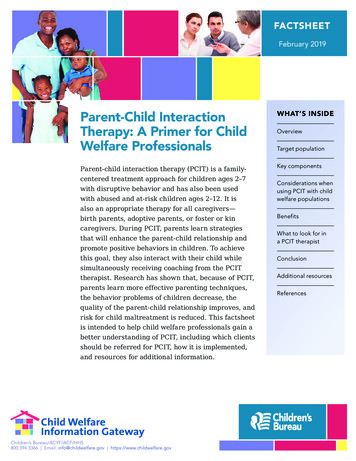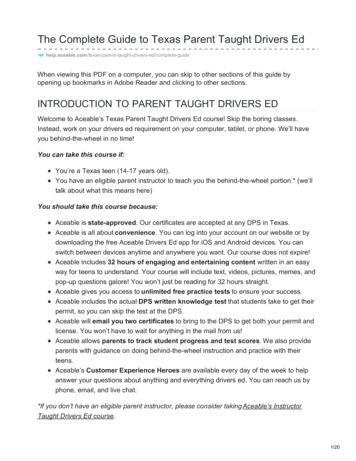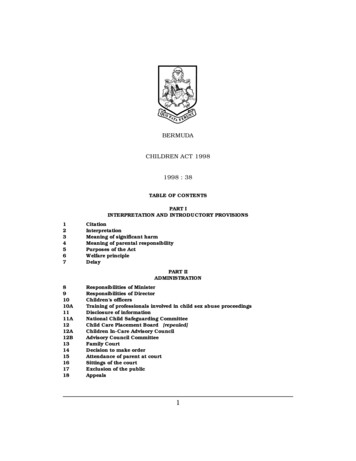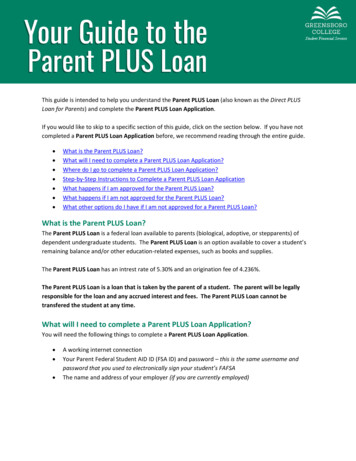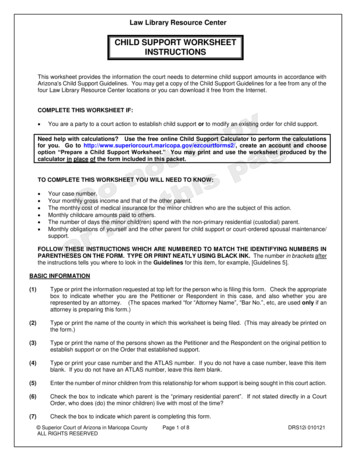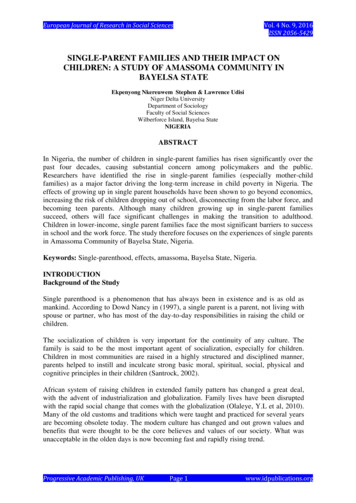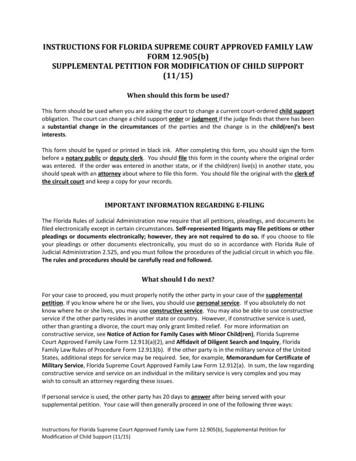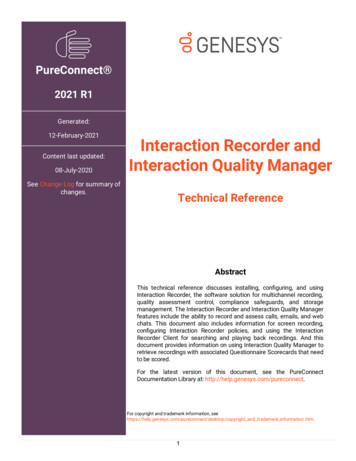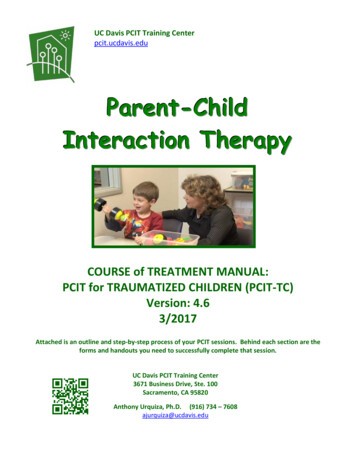
Transcription
UC Davis PCIT Training Centerpcit.ucdavis.eduParent-ChildInteraction TherapyCOURSE of TREATMENT MANUAL:PCIT for TRAUMATIZED CHILDREN (PCIT-TC)Version: 4.63/2017Attached is an outline and step-by-step process of your PCIT sessions. Behind each section are theforms and handouts you need to successfully complete that session.UC Davis PCIT Training Center3671 Business Drive, Ste. 100Sacramento, CA 95820Anthony Urquiza, Ph.D. (916) 734 – 7608ajurquiza@ucdavis.edu
PCIT for TRAUMATIZED CHILDRENTable of ContentsSECTION 1: GENERAL COURSE OF TRAINING & TREATMENT INFORMATIONPCIT Training Competencies . 1.1General Course of Treatment . . 1.7PCIT Flow Chart 1.9PCIT Flow Chart Key . 1.11Selecting the Right Toys . 1.15SECTION 2: INTAKE INFORMATIONIntake Assessment Checklist . . 2.1Steps for PCIT Intake Session . 2.3Inclusion & Exclusion Criteria . 2.5Consent to Video Tape PCIT Sessions . 2.7PCIT Assessment Measures Schedule . 2.9What to do with Standardized Measures . 2.11PCIT Data Log. . . . 2.13DPICS Protocol and Troubleshooting. . 2.15PCIT Behavioral Observation Instructions. .2.17Priority Order . . 2.1915-Minute DPICS Data Recording Sheet . 2.21PCIT Skill Acquisition Profile . 2.23PCIT Child Treatment Goals . 2.25PCIT Parenting Factors 2.27
Environmental Factors 2.29ECBI Coaching Words . 2.31Resources What is PCIT? Handout Child Trauma Handout Therapist Engagement Checklist Family Life QuestionnaireSECTION 3: CDI (RELATIONSHIP ENHANCEMENT) TEACHING INFORMATIONForms for CDI Teaching Session . 3.1Steps for CDI Teaching Session . . 3.3PRIDE Skills Handout . 3.5Ways to Praise! Handout . .3.7Selective Attention Handout . 3.9Toys for PCIT . . 3.11“HomeFun” Sheet . 3.13Rules for Special Playtime . . 3.15CDI & PDI Mastery Criteria . 3.17SECTION 4: CDI (RELATIONSHIP ENHANCEMENT) COACHING INFORMATIONForms for CDI Coaching Sessions . 4.1Steps for CDI Coaching Sessions . 4.35-Minute CDI Instruction . 4.5Weekly DPICS Data Recording Sheet 4.7Levels of Coaching . . 4.9Resources
UC Davis CDI Coaching Grid WACB-P (Weekly Assessment of Child Behavior)SECTION 5: MID-TREATMENT ASSESSMENTForms for Mid-Treatment Assessment 5.1Steps for Mid-Treatment Assessment . . 5.3Assessment of Interaction Quality . 5.5Skills to Manage Behaviors .5.7SECTION 6: PDI (STRATEGIES TO IMPROVE COMPLIANCE) TEACHING INFORMATIONForms for PDI Teaching Session. .6.1Steps for PDI Teaching Session. . 6.3Steps for Teaching Compliance Strategies. . 6.5BE DIRECT Skills Handout . 6.7PCIT Time Out: Simple. . . 6.9PCIT Time Out: Two-Choice. . . . 6.11Refusal Strategies: Back-Up Room; Swoop & Go. . 6.13Refusal Strategies: Removal of Privileges. . 6.15Two-Choice Removal of Privileges . . . . 6.17SECTION 7: PDI (STRATEGIES TO IMPROVE COMPLIANCE) COACHING INFORMATIONForms for PDI Coaching Sessions. . . 7.1PDI Coding Instructions .7.3Instructions for PDI Coding Sheet 7.5Coding Sheet: 5 minute CDI 2 minute PDI 7.7PDI Coaching for High-Risk Children . 7.9Steps for PDI Coaching Sessions . 7.11How to use the PDI Home Fun Sheet 7.13
PDI HomeFun Sheet . 7.15Setting Up House Rules .7.17Automatic Time Out . 7.19House Rule . 7.21Steps for Managing Behavior in Public 7.23Managing Difficult Behavior in Public . 7.25Resources UC Davis PDI Coaching Grid WACB-N (Weekly Assessment of Child Behavior)SECTION 8: PCIT GRADUATIONForms for Graduation Session 8.1Steps for PCIT Graduation Day . 8.3Sample Certificate of Completion . 8.5SECTION 9: PCIT EN ESPAÑOLIntake en EspañolDPICS Instructions Español . . 9.1Reseña de Adquisición de Habilidades de PCIT . 9.3ECBI Coaching Words Español . . 9.5Resources Que es PCIT? Handout Las Reacciones de los Niños al Trauma Cuestionario de FamiliaCDI en EspañolA Diario .9.9
Formas de Elogiar . 9.11Atención Selectiva . 9.13Juguetes de Preferencia CDI 9.15Tarea Semanal – Fortaleciendo la Relación Familiar . 9.17Criterios de Dominio de PCIT . 9.19Instrucciones de los 5 Minutos de CDI .9.21Bilingual Weekly CDI Coding Sheet 9.23Resources WACB-P EspañolMid-Treatment en EspañolHabilidades para Controlar las Conductas . 9.25PDI en EspañolSer Directo . 9.27Tiempo Aparte/Fuera: Sencillo . . 9.29Tiempo Aparte/Fuera de Dos Opciones . . 9.31Remover un Privilegio . 9.33Instrucciones de PDI . 9.35Hoja de Tarea Semanal en PDI . 9.37Establecimiento de Reglas para el Hogar . 9.39Regla de la Casa 9.41Como Controlar la Conducta Difícil en Publico .9.43Resources WACB-N Español
PCIT Trainee Name:PCIT Agency Name:PCIT for TRAUMATIZED CHILDRENPCIT COMPETENCIES FOR THERAPISTSESSENTIAL COMPONENTS OF PCIT Standardized pre/post treatment measurement – ECBI/DPICS Inclusion of CDI and PDI Coding interactions with the DPICS In vivo coaching of the parent-child dyad Inclusion of the PRIDE and selective attention/ignoring concepts Use of homework At least 50% of session spent coaching Agency provides appropriate space and equipment, and allows therapists toparticipate in ongoing training and consultation.MINIMUM REQUIREMENTS FOR BECOMING A PCIT THERAPIST Trainee must: 1) have a master’s degree or higher in the mental health field and mustbe actively working with children and families and 2) be licensed or supervised by aperson trained in PCIT. Graduate students enrolled in a master’s or doctorateprogram may participate in training within the context of their overall trainingprogram. 40 hours didactic training with role-play (including completion of PCIT-TC web course). Read revised or updated training handouts, training curriculum , PCIT book (McNeil &Hembree-Kigin, second edition, 2010), and selected research articles. Meet PCIT training Competencies for Therapist/Coach (UCDMC CAARE Center, 2000) Administer, score and interpret pre/post measures (ECBI, PSI, CBCL, TSCYC and 15minute observation with DPICS scoring) Supervision and case consultation through the course of treatment for one PCIT case. Remain current with PCIT research and advancements by attending regional meetings,annual PCIT conferences and other resources (i.e. PCIT Listserve, etc.) Complete two PCIT cases through the full course of treatment.Urquiza, A., Zebell, N., Timmer, S., & McGrath, J. (2015) PCIT: Sample Course of Treatment Manual for Traumatized Children. UnpublishedManuscript.1.1
PCIT Trainee Name:PCIT Agency Name:PHASE I: FUNDAMENTAL AND SKILL-BUILDINGDateApprovedbyExperiential Competency1.1 Complete 10 Hour PCIT –TC Web CourseEvaluation of Web Course Knowledge1.2 Meet Mastery Criteria for Child-Directed Interaction (CDI) Skills infive-minute role-plays (10 labeled praises, 10 reflections, 10behavioral descriptions with 3 or less questions, commands,critical statements)1.3 Code parent-child interaction using DPICS 3 with 80% accuracy1.4 Develop Objectives & Goals using information from clinicalinterview, pre-measures and behavioral observation1.5 Role-Play CDI Teaching Session – shows understanding of process1.6 Role-Play CDI Coaching Skills – shows understanding of process1.7 Role-Play PDI Teaching Sessions – shows understanding of process1.8 Role-Play PDI Coaching Skills – shows understanding of process1.9 Role-Play Presenting “What Is PCIT?” (pg. 2.37)PHASE II: EXPERIENTIAL TRAININGDateApprovedbyExperiential CompetencyIntake and Assessment2.1 Utilize standardized behavioral measurements (CBCL, ECBI, PSI,TSCYC) in assessment and treatment planning2.2 Conduct Structured Behavioral Observations (Dyadic Parent-ChildInteraction Coding System; DPICS) as a component of theassessment process2.3 Code 5-minute CDI parent-child interactions with 80% accuracyusing DPICS (10 times: check off below)Child-Directed Interaction Didactic3.1 Teach and demonstrate behavioral play therapy skills (PRIDE)3.2 Teach and demonstrate use of selective attention/ignoring3.3 Teach and demonstrate avoidance of questions, commands, andUrquiza, A., Zebell, N., Timmer, S., & McGrath, J. (2015) PCIT: Sample Course of Treatment Manual for Traumatized Children. UnpublishedManuscript.1.2
PCIT Trainee Name:PCIT Agency Name:critical statements3.4 Explain and provide rationale for completing daily homework3.5 Review toys that are appropriate for special play timeChild-Directed Interaction Coaching Sessions4.1 Model CDI Skills during all interactions with parent and child fromthe outset of contact to termination of session4.2 Use ten-minute check-in phase of therapy to build rapport andbriefly review progress/concerns/completion of homework4.3 Conduct 5-minute behavioral observation and code parent onPRIDE skills4.4 Coach easier-to-master skills (e.g., description, reflection,imitation) before more difficult skills (labeled praise, avoidingquestions & commands)4.5 Coach CDI skills by modeling, prompting, and explaining theconcepts using all levels of coaching4.6 Progress from directive to less directive coaching bypraising/reinforcing appropriate parent verbalizations (e.g. givemore praise than correction)4.7 Effectively coach concepts of ignoring and differential attention4.8 Coach qualitative aspects of parent-child interaction (e.g., physicalcloseness/affection, eye contact, vocal and facial expression,developmentally sensitive teaching, task persistence, frustrationtolerance, sharing, polite manners, and generalization of positivebehavior to other settings.)4.9 Provide five minutes of positive feedback to parents on theirmastery of skills and discuss homework plan4.10 Document parent and child progress, strengths, concerns, andtrack skill mastery on frequency chart4.11 Demonstrate ability to structure the opening and closing ofsessions so that feedback, homework, and review of child/parentprogress occurs4.12 Demonstrate ability to teach parent and use “Skills to ManageBehavior” in coaching sessionsMid-Treatment Assessment5.1 Use five-minute coding sessions to assess readiness for transitionUrquiza, A., Zebell, N., Timmer, S., & McGrath, J. (2015) PCIT: Sample Course of Treatment Manual for Traumatized Children. UnpublishedManuscript.1.3
PCIT Trainee Name:PCIT Agency Name:to Parent-Directed Interaction phase of treatment5.2 Administer standardized measures for re-assessing treatmentgoals5.3 Develop treatment goals specific for PDI phase of treatmentParent-Directed Interaction Didactic Session6.1 Provide rationale for teaching discipline skills to parents andemphasize the importance of continuing to use PRIDE skills6.2 Teach and demonstrate rules for giving effective commands (BEDIRECT)6.3 Teach and demonstrate importance of praise for compliance(COMMAND-COMPLY-PRAISE)6.4 Role-play ‘practice-minding’ and use of progressively moredifficult commands6.5 Teach and demonstrate time-out warning and time-out process6.6 Teach consistent process for managing time-out refusalParent-Directed Interaction Coaching Sessions7.1 Continue to model CDI Skills during all interactions with parentand child from the outset of contact to termination of session7.2 Use ten-minute check-in phase of therapy to briefly reviewprogress/concerns/completion of homework7.3 Conduct behavioral assessment at the beginning of the sessionaccording to protocol and code parent on BE DIRECT/Disciplinesequence7.4 Coach ‘practice-minding’ before ‘real life’ or more challengingcommands7.5 Coach time-out warning and time-out process7.6 Coach consistent process for managing time-out refusal7.7 Coach ‘real life’ directions and develop plan for implementingtime-out procedures in other settings7.8 Accurately explain the House Rules procedure7.9 Accurately explain Public Behaviors procedures7.10 Provide five minutes of positive feedback to parents on theirmastery of skills and discuss plan for carefully selecting necessarycommands to practice applying skills at homeUrquiza, A., Zebell, N., Timmer, S., & McGrath, J. (2015) PCIT: Sample Course of Treatment Manual for Traumatized Children. UnpublishedManuscript.1.4
PCIT Trainee Name:PCIT Agency Name:7.11 Document parent and child progress, strengths, concerns, andtrack maintenance of PRIDE skill mastery on frequency chart7.12 Assess readiness for treatment termination with parent based onlevel of compliance at home, school, and session, willingness tocooperate with time-outPost-Treatment Assessment8.1 Assess need for further therapy (e.g., trauma-focused therapy,social skills group) or adjunct services (e.g., home-based services,school consultation, medication assessment)8.2 Administer 15-minute behavioral assessment to measure parent’sachievement of skill acquisition and child’s compliance.8.3 Administer standardized behavioral measures (CBCL, ECBI, PSI,TSCYC, and TAI) to assess achievement of treatment objectives.8.4 Provide parent and child with certificate verifying achievement ofskill8.5 Document progress/objectives achieved and discharge planVerification of Training Completion:UCDMC PCIT TrainerPCIT TraineeDateDateUrquiza, A., Zebell, N., Timmer, S., & McGrath, J. (2015) PCIT: Sample Course of Treatment Manual for Traumatized Children. UnpublishedManuscript.1.5
Urquiza, A., Zebell, N., Timmer, S., & McGrath, J. (2015) PCIT: Sample Course of Treatment Manual for Traumatized Children. UnpublishedManuscript.1.6
PCIT for TRAUMATIZED CHILDRENGENERAL COURSE OF TREATMENTStep# ofSessionsExpectations1–2sessions 1Intake: Clinical Interview &AssessmentParent completes standardizedassessments & 15-minutebehavioral observation.2CDI Didactic1 session PRIDE Skills teaching session.3CDI Coaching6–8sessions Parent reaches mastery. Parent completes ECBI & PSI.Optional to complete othermeasures and 15-minuteobservation.4567Mid-Tx AssessmentUp to 1session PDI Didactic1–2sessionsParent learns how to giveeffective commands and a PCITtimeout. Role-play giving effectivecommands and PCIT timeoutwith Mr. Bear. Parent masters giving directcommands and time out withthe child.Child’s compliance improvesPDI Coaching with Role Play 1 sessionPDI Coaching6–8sessions 8Graduation from PCIT1–2sessions Parent gives effective commandsand manages behavior indifferent settings.Completes standardizedassessment measures, TAI, & 15minute behavioral observation.Urquiza, A., Zebell, N., Timmer, S., McGrath, J., & Whitten, L. (2011) Course of Treatment Manual for PCIT-TC. UnpublishedManuscript.1.7
Urquiza, A., Zebell, N., Timmer, S., McGrath, J., & Whitten, L. (2011) Course of Treatment Manual for PCIT-TC. UnpublishedManuscript.1.8
PCIT Flow ChartProgramDevelopmentPCIT ReferralsTreatmentCoordination MeetingIntake Session (1 – 2 hours)CDI Teaching – PRIDE/Selective Attention (1 hour)Coaching PRIDE/Selective Attention(6 – 8 hours)Mid Treatment Assessment(Up to 1 hour)PDI Teaching – BEDIRECT/Strategies to ImproveCompliance (1 – 2 hours)Coaching BE DIRECT/Strategies toImprove Compliance (6 – 8sessions)Prepare for Graduation (1 – 2 hours)Urquiza, A., Zebell, N., Timmer, S., McGrath, J., & Whitten, L. (2011) Course of Treatment Manual for PCIT-TC. UnpublishedManuscript.1.9
Urquiza, A., Zebell, N., Timmer, S., McGrath, J., & Whitten, L. (2011) Course of Treatment Manual for PCIT-TC. UnpublishedManuscript.1.10
PCIT Flow Chart KeyProgram Development Outfit and safety-proof the play room (toys, cabinets for toys)Outfit the observation room (cabinets for video, & forms)Purchase measurementso ECBI, PSI, CBCL, TSCYCCreate case foldersCreate pre- & post-measurement packetsCreate packets of information for teaching PCIT componentsXerox PCIT Log Sheets – to use a temporary data baseSchedule roomKeep supply of ear batteries and DVDsPost handouts in PCIT observation roomo 15-minute observationo Lead-in for 5-minute observationo Mastery CriteriaDevelop video taping consent formPCIT Referrals(Indicate on referral: PCIT only/PCIT adjunct to other treatment) Referrals from within agency will contact:Referrals from outside agency will contact:Treatment Coordination Meeting Assign Case to TherapistInput data in databaseTransfer case file to therapistIntake Session (1 – 2 hours)Urquiza, A., Zebell, N., Timmer, S., McGrath, J., & Whitten, L. (2011) Course of Treatment Manual for PCIT-TC. UnpublishedManuscript.1.11
Clinical interviewConsent to video tapePre measurements completed and interpretedo ECBI, PSI, CBCL, TSCYC15 minute recorded observation (after obtainingvideo release)Develop treatment goals using ECBI/Coaching words listCDI Teaching – PRIDE/Selective Attention(1 hour)*pre-measurements must be completed prior to the PRIDE Training* Teach the pride concepts/selective attention Emphasize practicing to “mastery” (Skill Acquisition Profile) Provide packet of handouts to parento PRIDEo Ways to Praise!o Selective Attentiono Toys Listo Daily HomeFun SheetCoaching PRIDE/Selective Attention(6 – 8 hours) 10 minute check-in5 minute coding at beginning of every session-video tape30 minutes of coaching5 minute of session review and homework assignmentCoach parent to Mastery*: Skill Acquisition ProfileMid Treatment Assessment(Up to 1 hour)Assess whether parent is at Mastery** 10 Labeled Praises* 10 Reflections* 10 Behavioral Descriptions* 3 or fewer critical statements/questions/commandsReassess treatment objectives and goals by completing ECBI and PSIUrquiza, A., Zebell, N., Timmer, S., McGrath, J., & Whitten, L. (2011) Course of Treatment Manual for PCIT-TC. UnpublishedManuscript.1.12
Conduct 15-minute behavioral observation (as needed)PDI Teaching –BE DIRECT/Strategies to Improve Compliance(1 – 2 hours)Teach Strategies to Improve Compliance concepts using Mr. Bear for role playGive parent handouts Skills to Manage Behaviors Giving Effective Commands Giving Effective Time-Outs Strategies to Improve Compliance Daily Home-Fun SheetCoaching BE DIRECT/Strategies to Improve Compliance(6 – 8 sessions) 10 minute check-in5 – 10 minute coding at beginning of every session-video tape30 minutes of coaching5 minute of session reviewCoach parent to Mastery*o *command comply praiseo *Following time out processIntroduce house rules, automatic time-out, and skills to use in publico Practice to Masteryo Make home-visit or public visit as neededCoach to Graduation*o *75% of parent’s commands must be effectiveo *Child’s ECBI intensity score must be lower than 114Prepare for Graduation (1 – 2 hours) Assure that all post measurements are completedComplete 15-Minute Recorded ObservationRefer family to other treatment as neededComplete PCIT Log SheetUrquiza, A., Zebell, N., Timmer, S., McGrath, J., & Whitten, L. (2011) Course of Treatment Manual for PCIT-TC. UnpublishedManuscript.1.13
Urquiza, A., Zebell, N., Timmer, S., McGrath, J., & Whitten, L. (2011) Course of Treatment Manual for PCIT-TC. UnpublishedManuscript.1.14
SSEELLEECCTTIINOYYSS::HTT TTOGHHEE RRIIGG TTHNGAA KKeeyy ttoo SSuucccceessss iinn PPCCIITTWhen selecting toys for your session, think about your client and what you want to accomplish. The toys youchoose will help you achieve your goals. Think about how old children are, their motor coordination, and their taste in toys.You may also consider whether a toy poses a safety hazard (e.g., choking).Think about whether you want the parent and child to play together or to play apart.Think about whether parents need a really fun toy to keep children interested inplaying with them.Think about whether the child might have a meltdown or require a time out.While it is all right to use other toys, the toys listed below have traditionally been successful for PCIT sessions.Toys for Most 2 – 7 yr oldsToys for Younger ChildrenToys for Older ChildrenFoam blocksPop-beadsSmall LegosLittle People toysDuplo blocks (large Legos)Gears (building gears)Play-Doh with molds, shapes, & cuttersMegga blocks (giant Legos)MagnetixPlay food, dishes, pots, & pansRing stacker with soundsTinker Toys (plastic)Potato Heads (at least two so that both parent & childcan play)Xylophone, or other musicalinstruments that do not go in themouthMatchbox or Hotwheels carsWooden train & trackPop-up toyKid KinexPlastic play figures with terrain/play mats: farmanimals, dinosaurs, jungle animalsToys with a small amount ofsound, music, or lightsMotorworks (cars to build)Bristle Blocks (Krinkles brand with wheels and figures)Soft toys, or small plush animalsMarble ToyWashable crayons and paperSorting blocks, nesting toysSimple, non-directive arts andcraftsYou may also consider selecting the following toys to give you more options in coaching around trauma, and in PDI: Games like Candy Land or Chutes & Ladders, or puzzles to help build frustration tolerance and improveturn-takingBaby dolls and accessoriesPlay family figures, all ages and ethnicitiesFischer-Price school house and playgroundPlay furniture, with beds, toilets, and bathtubsCars and trucks, esp. police cars, ambulances, and fire trucksUrquiza, A., Zebell, N., Timmer, S., McGrath, J., & Whitten, L. (2011) Course of Treatment Manual for PCIT-TC.1.15Unpublished Manuscript.
Urquiza, A., Zebell, N., Timmer, S., McGrath, J., & Whitten, L. (2011) Course of Treatment Manual for PCIT-TC.1.16Unpublished Manuscript.
UC Davis PCIT Training Center . pcit.ucdavis.edu . Parent-Child Interaction Therapy . COURSE of TREATMENT MANUAL: PCIT for TRAUMATIZED CHILDREN (PCIT-TC) Version: 4.6 . 3/2017 . Attached is an outline and step-by-step process of your PCIT sessions. Behind each section are the forms and handouts you need to successfully complete that session.
